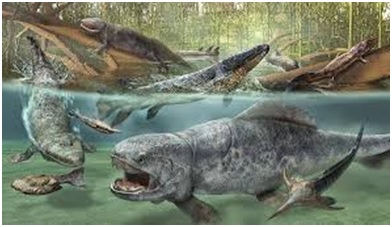This is the seventh part of The Ancients, a series of posts which, by this time, I’m pretty sure all you natural history lovers know and love, so I’ll get straight to the point. Check out parts 1-6 before this one!
Name: Devonian
Period: 419.2-358.9 m.y.a
Average Temperature: 20 Celsius
Atmospheric oxygen: 15%

After the boom of land plants in the Silurian, everything was looking good. The Devonian was pretty warm overall, with a few glaciations here and there. Weather was hot and dry, weirdly, and the islands were starting to join together, which would soon result in a supercontinent (But I’m not the one to give spoilers). Fish started migrating from the South to what would eventually become North America and Europe. The climate back then was pretty messed up though; Canada; the snowy, frozen Canada that we all know, used to be equatorial. That means HOT. And HUMID. Basically, the polar opposite of Canada. Anyways, forests were starting to grow in Canada, and everything was calm. Until the MASS EXTINCTION which DESTROYED nearly 75% of ALL LIFE. ALL. LIFE. But we’ll get to that.
The Late Devonian Extinction was one of the five major extinction events that have occurred in the Earth’s history. It consisted of two parts: the Kellwaser and the Hangenberg events. It mostly affected marine life, completely wiping out many major fish groups and devastating coral and invertebrates. It also destroyed 97% of all vertebrae species. (which set the world back MAJORLY, since backbones were like, the next evolution.) After this event, most fish barely exceeded 10 CENTIMETERS, and the biggest were sharks that were only a METER long, and it would take almost 10 MILLION YEARS before they got bigger. However, this extinction cleared the way for modern aquatic vertebrates, like amphibians. Why did this extinction happen? We don’t know, but there are a few theories. One, it was an asteroid that killed everything, like the dinosaurs. Second, the change in plants caused an excess of nutrients in the water, which led algae and moss to grow on the surface of the water, which killed everything due to lack of oxygen in the water. Third, the reduction of carbon dioxide due to, well, PLANTS, lead to global cooling which killed everything. (I think I’m starting to see a pattern here.) The last, is that volcanoes killed everything. Pretty self-explanatory.
Life was spread between land plants and fish, with a few amphibians mixed in here and there. Plants evolved actual leaves and roots and diversified. There were so many fish, that this eon is nicknamed ‘The Age of Fish’. The ancestors of back-boned animals began to evolve to walk on land. A great, thousand-kilometer long, barrier reef used to exist in what is now the Kimberly basin, in North-west Australia.
Prototaxites were lichen that formed tall, trunk-like structures, and appeared in the Late Silurian. Wattieza is the oldest genus of tree that was closely related to ferns and horsetails. Archaeopteris (not the prehistoric bird, that’s Archaeopteryx) was a genus of tree with fern-like leaves, which grew next to rivers. It is the ancestor of gymnosperm trees (basically trees with pinecones).
For fish, Tiktaalik was representative of the transition from aquatic to terrestrial animals, adapting to oxygen-poor water. Ichthyostega was one of the first tetrapod (mammal, reptile, bird, amphibian). It lived in swamps and had lungs and limbs which let it navigate shallow water. It also had gills and a fish-like tail. Materpisces, a peculiar species, known only from one specimen, found nearby Western Australia. From the specimen, scientists saw that it had an unborn embryo preserved, along with a placenta-like structure. This shows that Materpiscis attenboroughi, named in the honour of David Attenborough, was the oldest known animal which gave live birth. Bothriolepis was a widespread genus of placoderms, which fed on algae and micro-organisms. Cladoselache was one of the earliest known shark groups and were fast predators. Unlike most sharks, they had short, rounded, mouths. Another tetrapod was Acanthostega, which had 8 digits on its four limbs, linked by webbing. It also lived in swamps. Lastly, Dunkleosteus was a hypercarnivorous placoderm with an armored exterior.
Sorry this blog was longer than usual. As we go on, there’ll be more to talk about.
Shaurya Prasad Grade 7A